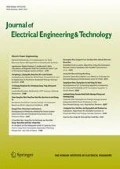Abstract
The paper presents the method of thermal field analysis in a rectangular busbar taking into account the variable resistivity. The method is based on the analytical solution of the heat conduction equation. The boundary-initial problem was solved using the Duhamel’s theorem. The suitable step response of the system was determined by the separation of variables method. By means of presented method, a stationary and transient thermal field was determined in the rectangular busbar taking into account variable resistivity. The steady-state currents rating as well as the time constants of the busbar in case of variable and average resistivity were also determined. The results obtained was verified using the finite element method.




Similar content being viewed by others
References
Lei J, Zhong JY, Wu SJ, Wang Z, Guo YJ, Qin XY (2016) A 3-D steady-state analysis of thermal behavior in EHV GIS busbar. J Electric Eng Technol 11(3):781–789
Kim HK, Oh Y-H, Lee SH (2009) Calculation of temperature rise in gas insulated busbar by coupled magneto-thermal-field analysis. J Electric Eng Technol 4(4):510–514
Grigsby LL (2012) Electric power generation, transmission, and distribution, 3rd edn. Taylor & Francis Group, Boca Raton (chap 14)
Coneybeer RT, Black WZ, Bush RA (1994) Steady-state and transient ampacity of bus bar. IEEE Trans Power Deliv 9:1822–1829
Nithiarasu P, Lewis RW, Seetharamu KN (2016) Fundamentals of the finite element method for heat and mass transfer. Wiley, New York
Liu S-B, Han X (1998) Analytical method of calculating and steady-state temperature rises for cable-bundle in tray and ladder. IEEE Trans Power Deliv 13:691–698
Liu S-B (2010) Calculation of the steady-state and transient temperature rises of round cable bundles. IEEE Trans Power Deliv 25:1229–1235
Hoffer O (1978) Instationäre Temperaturverteilung in Einem Runddraht. Arch Elektrotech 60:319–325
Barletta A, Zanchini E (1994) Time averaged temperature distribution in a cylindrical resistor with alternating current. Heat Mass Transf 29:285–290
Gołębiowski J, Zaręba M (2006) A method of the analysis of the thermal field dynamics in a core and insulation of a DC lead with convectional heat abstraction. Electric Eng 88(5):453–464
Gołębiowski J, Zaręba M (2009) A method of analysing the thermal field in a three-zone polymeric cable. COMPEL Int J Comput Math Electric Electron Eng 28(2):320–340
Hahn DW, Ozisik MN (2012) Heat conduction. Wiley, New Jersey
Akamatsu M, Guo Z (2013) Comparison of transmitted pulse trains predicted by Duhamel’s superposition theorem and direct pulse simulation in a 3-D discrete ordinates system. Numer Heat Transf Part B 63:189–203
Anders GJ (1997) Rating of electric power cables: ampacity computations for transmission, distribution, and industrial applications. McGraw-Hill Professional, New York
Incropera FP, Dewitt DP, Bergman TL, Lavine AS (2007) Introduction to heat transfer. Wiley, New York
Cole KD, Haji-Sheikh A, Beck JV, Litkouhi B (2011) Heat conduction using Green’s functions. CRC Press, New York
Jing LB, Luo ZH, Liu L, Gao QX (2016) Opimization design of magnetic gear based on genetic algorithm toolbox of Matlab. J Electric Eng Technol 11(5):1202–1209
Zhou Y, Li H, Wang W, Cao Q, Zhou S (2015) Improved method for calculation magnetic field of surface-mounted permanent magnet machines accounting for slots and eccentric magnet pole. J Electric Eng Technol 10(3):1025–1034
Wolfram Research Inc (2018) Mathematica. Wolfram Research Inc., Champaign
Acknowledgements
The paper was prepared at the in Bialystok University of Technology within the framework of the project S/WE/2/18 sponsored by the Ministry of Science and Higher Education.
Author information
Authors and Affiliations
Corresponding author
Rights and permissions
About this article
Cite this article
Zaręba, M. Application of Duhamel’s Theorem in the Analysis of the Thermal Field of a Rectangular Busbar. J. Electr. Eng. Technol. 14, 47–53 (2019). https://doi.org/10.1007/s42835-018-00045-1
Received:
Revised:
Accepted:
Published:
Issue Date:
DOI: https://doi.org/10.1007/s42835-018-00045-1



